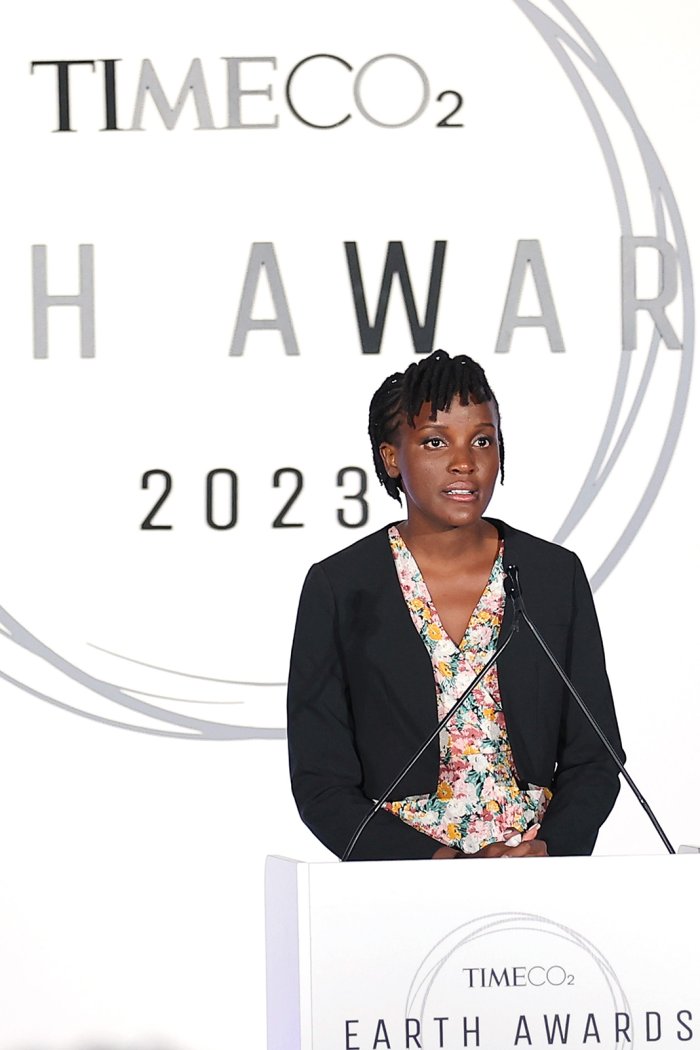Lisa P. Jackson is one of TIME’s 2023 Earth Award honorees.
Apple revolutionized consumer technology. Now it’s focused on the climate crisis. For the company’s head of environment, policy, and social initiatives, Lisa P. Jackson, this requires “the same kind of innovation and integrity that we bring to our products.”
After leading the Environmental Protection Agency from 2009 to 2013 under President Barack Obama, Jackson joined Apple. Her decade of work there “is something that I will put up there in my career right up alongside my time in government service, and my 25 years in public service,” she says. “I’m really proud.” Jackson has steered the company to carbon neutrality across its global corporate operations; pushed for suppliers to use renewable energy; and spearheaded its Racial Equity and Justice Initiative.
She is currently working toward carbon neutrality across Apple’s entire business and supply chain by 2030. That means reducing the fossil fuels used to produce Apple products; grappling with the environmental harm caused by extracting essential metals; and prioritizing recycling of device components when customers throw away or trade in devices and using recycled materials to build shiny new ones—using 40% recycled materials in the MacBook Air with an M2 chip, for instance, cut its emissions impact by 30%. A lot is involved. Consider the efforts, pictured below, to make the iPhone more sustainable.

1. Life-cycle impact: The life-cycle carbon footprint of an iPhone 14 Pro with 128GB of storage is 65 kg, equivalent to driving 160 miles in a gas-powered car. Production makes up 81% of this footprint; Apple is working to reduce such related emissions, and as of 2023, over 20% of iPhone 14 manufacturing electricity is sourced from clean energy.
2. Energy efficiency: Over the phone’s entire life cycle, 15% of its carbon footprint comes during use. While different people use their devices differently, the iPhone generally requires 54% less energy than the U.S. Department of Energy’s mandated levels.
3. A cleaner way to charge: To have a truly climate-friendly product, the electricity to charge a device should come from renewable sources. Often this is out of Apple’s hands, though in Brown County, Texas, the company in 2019 invested in the 320-megawatt IP Radian Solar project to help consumers source cleaner energy.
4. Recycled metals: In April 2023, Apple announced that by 2025, all cobalt in all of its batteries will be recycled. The company also committed to using only recycled rare earth elements in all its magnets by the same deadline. Apple’s battery magnets use only recycled metals already.
5. Tapping into tungsten: A quarter of all the rare earth metals used in an iPhone are found in the Taptic Engine, which creates the vibration you feel when you receive a text, and the click when you type. This requires tungsten, a so-called conflict mineral commonly mined in the Democratic Republic of Congo. Apple today uses 100% recycled tungsten in the Taptic Engine.
6. Transport emissions: Transportation accounts for 1% to 10% of a device’s carbon footprint. For the iPhone 14 Pro, the number is 3%. Decarbonizing this process is tricky given that long-haul flights rely on fossil fuels. To tackle this, Apple aims to use less carbon-intensive transport where possible, along with nature-based carbon offsets.
7. End of life recycling: In 2022, roughly 5.3 billion mobile phones were thrown away. Globally, only 17% of e-waste is properly recycled. Apple estimates that the metals like gold and copper it recovers from a metric ton of iPhone components avoids mining 2,000 metric tons of raw material from the earth.
—With reporting by Justin Worland
Correction, April 20
The original version of this story misstated Jackson’s title. She is the head of environment, policy, and social initiatives, not head of sustainability.
- Cybersecurity Experts Are Sounding the Alarm on DOGE
- Meet the 2025 Women of the Year
- The Harsh Truth About Disability Inclusion
- Why Do More Young Adults Have Cancer?
- Colman Domingo Leads With Radical Love
- How to Get Better at Doing Things Alone
- Michelle Zauner Stares Down the Darkness






